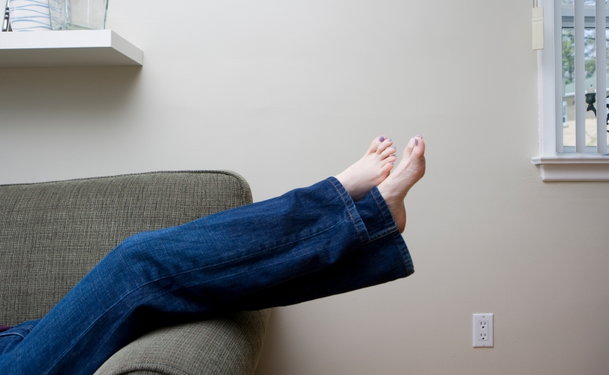Varicose veins are enlarged, twisted veins near the surface of the skin. They are usually found in the legs, but can also occur in other parts of the body.
For many people, varicose veins cause few signs or symptoms, although you may be concerned about the way they make your legs look. If you want to improve the look of your legs, or your symptoms are more severe, a vein specialist can help you find a varicose vein treatment that is right for you.
These at-home practices and lifestyle changes can provide temporary relief of minor symptoms.
Relieving varicose vein symptoms at home
If you haven’t scheduled an appointment yet with a vein specialist to have your varicose veins treated, or you are waiting for your appointment, there are several things you can do at home to relieve your symptoms, such as:
- Take regular breaks to move around if you stand or sit for long periods. Avoid crossing your legs while sitting.
- Raise your legs while you are sitting or sleeping, above the level of your heart if possible. This can keep the blood from pooling in the veins in your legs.
- Exercise regularly. Moderate- to vigorous-intensity physical activity can improve the muscle tone in your legs. This can help the blood move through your veins.
- Maintain a healthy weight. Being overweight or obese can increase your risk of developing varicose veins and may worsen your symptoms.
- Avoid wearing tight clothes, especially ones that are tight around the legs, groin and waist. These can restrict the flow of blood in your veins.
- Avoid wearing high heels for long periods. This can increase the pooling of blood in the veins in your legs. Shoes with low heels will also tone your leg muscles more, which helps the blood flow through the veins.
- Wear compression stockings, which provide gentle pressure to reduce pooling of blood and swelling in the legs. Compression stockings are available over-the-counter or from pharmacies and medical supply stores with a prescription.
Treatment options for varicose veins
While these at-home practices may relieve your symptoms temporarily, they will not eliminate the varicose veins. Several vein treatments are available that can get rid of your existing varicose veins, including:
- Sclerotherapy: A special chemical is injected into the vein, which causes scarring that closes off the vein. Over time the vein will fade away.
- Laser therapy: Focused light is used to make the vein fade away. This treatment does not require any chemicals or cutting.
- Endovenous ablation therapy: A small tube (catheter) is inserted into the varicose vein through a tiny cut in the skin. The tip of the tube creates heat which closes off the vein.
- Endoscopic vein surgery: A small tube with a camera is inserted into the vein through a tiny cut in the skin. A surgical tool at the end of the tube closes off the vein. This is used in severe cases of varicose veins.
- Ambulatory phlebectomy: Varicose veins are removed surgically through several small cuts in the skin. This is often combined with other procedures to quickly remove superficial varicose veins.
- Vein stripping and ligation: Varicose veins are surgically tied shut and removed through small cuts in the skin. This is now uncommonly performed and mostly replaced by endovenous ablation.
If you decide to wait to have your varicose veins treated, keep an eye out for worsening of your symptoms. Severe symptoms can include pain, blood clots or sores on the skin (ulcers) near the varicose veins. These symptoms can be a serious health concern and require medical care. Varicose veins will not go away on their own, and in some cases they may worsen. If you develop any of these symptoms, contact a vein specialist for treatment. Many vein treatments are fast, effective and have a short recovery.
Updated Aug. 23, 2017


